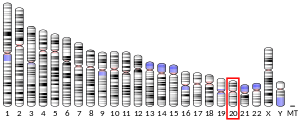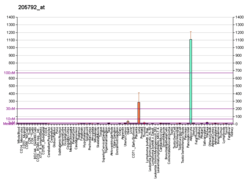WNT1-inducible-signaling pathway protein 2
WNT1-inducible-signaling pathway protein 2, or WISP-2 (also named CCN5) is a matricellular protein that in humans is encoded by the WISP2 gene.[5][6]
Function
The CCN family of proteins regulates diverse cellular functions, including cell adhesion, migration, proliferation, differentiation.[7][8][9]
Structure
WISP-2 is a member of the CCN family (CCN intercellular signaling protein) of secreted, extracellular matrix (ECM)-associated signaling matricellular proteins. The CCN acronym is derived from the first three members of the family identified, namely CYR61 (CCN1), CTGF (connective tissue growth factor, or CCN2), and NOV. These proteins, together with WISP1/CCN4, WISP2 (CCN5, this gene), and WISP3 (CCN6) comprise the six-member CCN family in vertebrates. CCN proteins characteristically contain an N-terminal secretory signal peptide followed by four structurally distinct domains with homologies to insulin-like growth factor binding protein (IGFBP), von Willebrand type C repeats (vWC), thrombospondin type 1 repeat (TSR), and a cysteine knot motif within the C-terminal (CT) domain. However, WISP-2 is unique among this family of proteins by lacking precisely the CT domain.
Clinical significance
WISP-2 (CCN5) inhibits the proliferation of vascular smooth muscle cells,[10] human uterine myometrial cells, and leiomyoma cells.[11] Ectopic expression of WISP-2 also inhibits the motility and invasiveness of breast carcinoma cells.[12][13] WISP-2 also inhibits cardiac hypertrophy and fibrosis, an effect that appears linked to the absence of the CT domain.[14]
References
- GRCh38: Ensembl release 89: ENSG00000064205 - Ensembl, May 2017
- GRCm38: Ensembl release 89: ENSMUSG00000027656 - Ensembl, May 2017
- "Human PubMed Reference:". National Center for Biotechnology Information, U.S. National Library of Medicine.
- "Mouse PubMed Reference:". National Center for Biotechnology Information, U.S. National Library of Medicine.
- Jun JI, Lau LF (Dec 2011). "Taking aim at the extracellular matrix: CCN proteins as emerging therapeutic targets". Nature Reviews. Drug Discovery. 10 (12): 945–63. doi:10.1038/nrd3599. PMC 3663145. PMID 22129992.
- Russo JW, Castellot JJ (Oct 2010). "CCN5: biology and pathophysiology". Journal of Cell Communication and Signaling. 4 (3): 119–30. doi:10.1007/s12079-010-0098-7. PMC 2948116. PMID 21063502.
- Chen CC, Lau LF (Apr 2009). "Functions and mechanisms of action of CCN matricellular proteins". The International Journal of Biochemistry & Cell Biology. 41 (4): 771–83. doi:10.1016/j.biocel.2008.07.025. PMC 2668982. PMID 18775791.
- Holbourn KP, Acharya KR, Perbal B (Oct 2008). "The CCN family of proteins: structure-function relationships". Trends in Biochemical Sciences. 33 (10): 461–73. doi:10.1016/j.tibs.2008.07.006. PMC 2683937. PMID 18789696.
- Leask A, Abraham DJ (Dec 2006). "All in the CCN family: essential matricellular signaling modulators emerge from the bunker". Journal of Cell Science. 119 (Pt 23): 4803–10. doi:10.1242/jcs.03270. PMID 17130294.
- Lake AC, Bialik A, Walsh K, Castellot JJ (Jan 2003). "CCN5 is a growth arrest-specific gene that regulates smooth muscle cell proliferation and motility". The American Journal of Pathology. 162 (1): 219–31. doi:10.1016/S0002-9440(10)63813-8. PMC 1851113. PMID 12507905.
- Mason HR, Lake AC, Wubben JE, Nowak RA, Castellot JJ (Mar 2004). "The growth arrest-specific gene CCN5 is deficient in human leiomyomas and inhibits the proliferation and motility of cultured human uterine smooth muscle cells". Molecular Human Reproduction. 10 (3): 181–7. doi:10.1093/molehr/gah028. PMID 14981145.
- Fritah A, Saucier C, De Wever O, Bracke M, Bièche I, Lidereau R, Gespach C, Drouot S, Redeuilh G, Sabbah M (Feb 2008). "Role of WISP-2/CCN5 in the maintenance of a differentiated and noninvasive phenotype in human breast cancer cells". Molecular and Cellular Biology. 28 (3): 1114–23. doi:10.1128/MCB.01335-07. PMC 2223394. PMID 18070926.
- Banerjee S, Dhar G, Haque I, Kambhampati S, Mehta S, Sengupta K, Tawfik O, Phillips TA, Banerjee SK (Sep 2008). "CCN5/WISP-2 expression in breast adenocarcinoma is associated with less frequent progression of the disease and suppresses the invasive phenotypes of tumor cells". Cancer Research. 68 (18): 7606–12. doi:10.1158/0008-5472.CAN-08-1461. PMID 18794149.
- Yoon PO, Lee MA, Cha H, Jeong MH, Kim J, Jang SP, Choi BY, Jeong D, Yang DK, Hajjar RJ, Park WJ (Aug 2010). "The opposing effects of CCN2 and CCN5 on the development of cardiac hypertrophy and fibrosis". Journal of Molecular and Cellular Cardiology. 49 (2): 294–303. doi:10.1016/j.yjmcc.2010.04.010. PMID 20430035.




